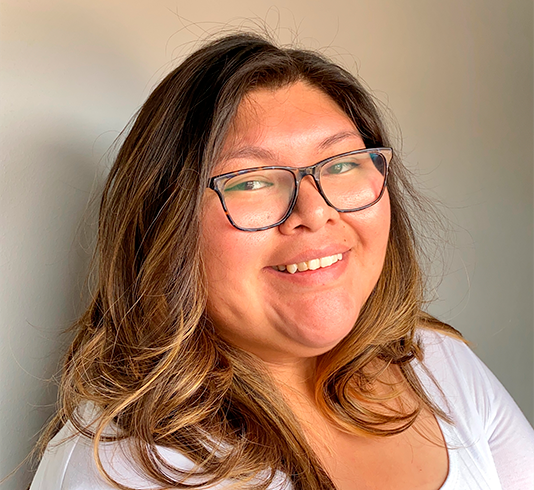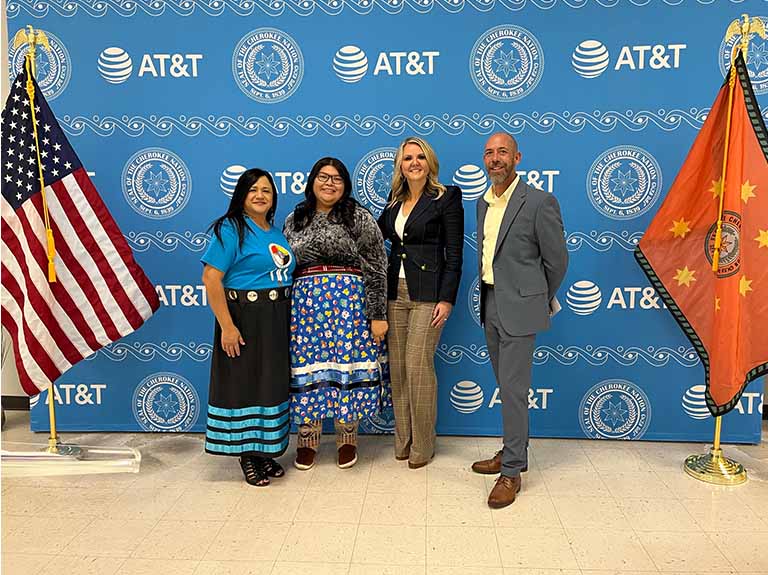Yá’át’ééh shik’éí dóó shidine’é. Angel Benally yinishyé. Show Low, Arizona déé’naashá. Tsé njíkini dine’é éí nishłí. Táchii’nii dine’é éí báshíshchíin. Kinyaa’áanii dine’é éí dashicheii. Bit’ahnii dine’é éí dashináli.
Hello my friends and relatives. My name is Angel Benally. I am from Show Low, Arizona. I am Cliff Dweller People Clan. I am born for Red Running into the Water Clan. My maternal grandfather’s clan is Towering House Clan. My paternal grandfather’s clan is Within His Cover Clan.
While Native American Heritage Month (NAHM) is an ideal time to honor and learn about Indigenous people’s contributions and traditions to society, it’s also important to recognize that every day is a good day to celebrate Indigenous people. As a member of the Diné (Navajo Nation), this is especially true for me, and I believe it can be true for others too. After all, we all live, work and play on native land.
For me, NAHM is a time to gather and be with family and community. The value of togetherness is an important theme in our community and one that has sustained across generations of Native American tribes.
This month also provides us with an opportunity to appreciate where we are today, as Native people, and the future generations that are to come, while also reflecting on our history. When I think about ways that others can engage and celebrate NAHM, two things come to mind.
The first is education: Where you are, physically, in this moment? Do you know what land, or more critically, whose land you’re on? Researching and learning about the original stewards and inhabitants of the land where you live not only deepens the sense of connection to your surroundings and community, it also helps you understand the history and capabilities of the land.
Land acknowledgements are important for this reason. It honors the people that lived in the places we occupy now and recognizes the original purpose for the land. For me, land acknowledgments are also a reminder of what’s possible with and from the land. It reminds us of what we can plant and grow, whether it’s seeds in the ground or stowing education and curiosity among dominant culture. The below video is a great example from my colleagues about how land acknowledgments increase visibility of Native people and offer opportunities to learn.
Another way to celebrate NAHM is by becoming an ally. Allyship isn’t always about offering solutions; it can be about listening – listening to understand and advocate.
I experienced the power of advocacy a couple of years ago. At the height of the pandemic, I faced a personal frustration. Living on a reservation, I experienced the need for reliable internet in order to continue working and progressing in my career. And while lack of connectivity wasn’t a new struggle for my community, access to internet suddenly became a true requirement through the new realities of remote work. Through this struggle, the disconnect between the lived experiences of native people and the world at large was amplified.
I saw how my community was being left behind as the world pivoted to remote work and school, and I knew I had a part to play in advocating for this issue. Through my role as a Tribal Affairs Specialist for FirstNet®, Built with AT&T and as a first-generation professional I was, and still today serving as a connector between my community and the work we are doing to help bridge the digital divide and ensure access to high-quality internet. Simultaneously, I’m also able to help my community gain knowledge by way of me sharing what I learn and providing access to resources.
And while it’s a responsibility and privilege for me to be able to serve my community in this way, not every community has the connections to the resources they need. This is why I’m proud of the work AT&T is doing to bring Connected Learning Centers to underserved communities across the nation. Having access to basic resources – like computers and reliable internet – opens the door for the next generation to succeed. I was the first person in my family to graduate college and I want my community—and the next generation—to have the option to achieve the same, and even greater possibilities.
Which brings me back to the topic of community. While community is core to Indigenous people, a desire for togetherness lives within all of us. During NAHM, I invite you to learn and reflect on your connectedness to the land where you reside. I also encourage you to consider our togetherness as collective people and how you can help advocate for the needs of someone else.
Ahéhee’. Thank you.
HTML Editor Component
*Contents may not have visible height
Read more Diversity news



